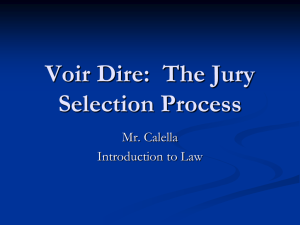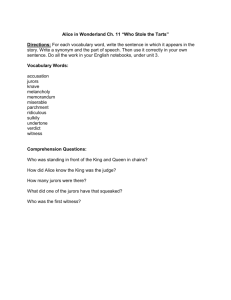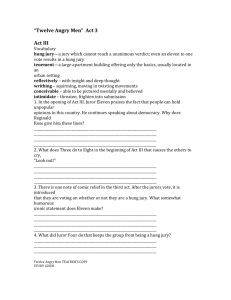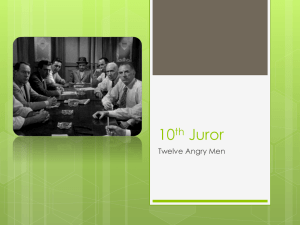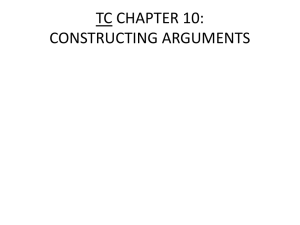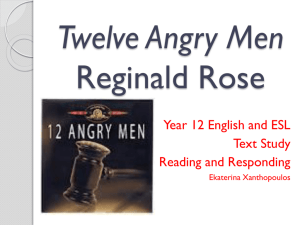Social & Legal Slides
advertisement
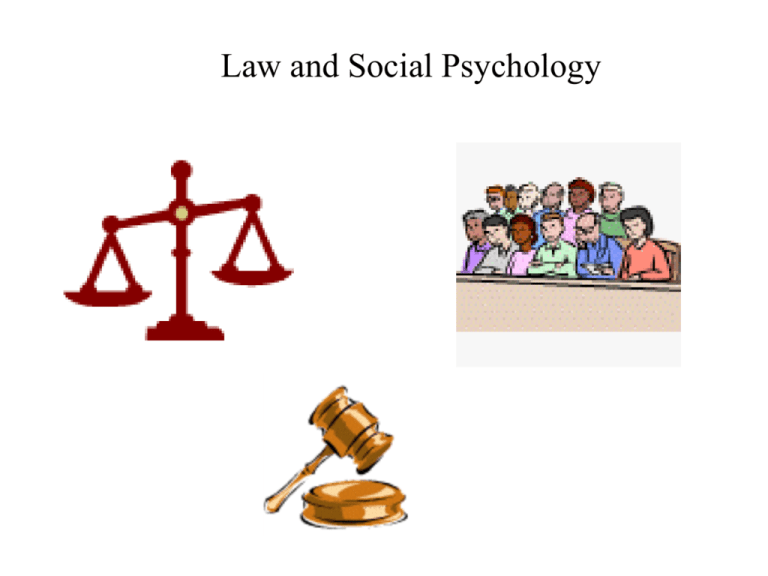
Law and Social Psychology The Jury Pool and Representation Issues Based on the Jury Service and Selection Act (1968) Required Sources: • Voter Registration Lists Optimal Sources: • Licensed Drivers • People on Public Assistance • Unemployment Lists • Stratify the sample to issue more jury summons to traditionally underrepresented groups * Representation is not required for every jury pool; the juries must be representative across several years • No agreement on the practical meaning of representativeness (e.g., Louisiana case where underrepresentation of poor was not found to violate the JSSA) • Study of jury composition in US District Court in MA – Process discriminated against poor, young, racial minorities, and those with little formal education Jury Selection or Voir Dire (Actually a process that excludes potential jurors) Peremptory challenges: Excluding jurors without having to offer any specific reasons (number is known in advance and varies by jurisdiction, type of case, and severity of the charge) Examples: Death Penalty cases cases --- Lesser felonies: California = 26 challenges for each side New York = 15 each side Virginia = 4 to each side WV = 2 for prosecution HI, NH = 3 for defense Federal Government felony cases = 6 for prosecution; 10 for defense • For cause challenges: Exclusion of jurors for specific reasons such as being biased, prejudiced against one of the parties, or having a relationship to one of the parties that creates the appearance of bias: For cause challenges are relatively rare: Estimate taken from 3 years of jury selection in New Mexico --- 1/20 eliminated for cause Information Used to Select Jurors Type and amount of questions are often impacted by the type of case involved (e.g., murder, sexual assault, child abuse, drug offense) • Most Federal Courts – Judges question potential jurors • Most Local Courts – Attorneys question potential jurors Demographic information (e.g., gender, race, social economic status, age, religion, occupation or occupational level, education, political affiliation) Overall, a mixed and inconsistent relationship to eventual verdict Personality Characteristics (e.g., authoritarianism, locus of control, just world beliefs, Big 5 personality variables of conscientiousness, agreeableness, emotional stability, extraversion, openness to experience) Jury Consultant Questionnaires (so-called “scientific jury selection’) ~ General Voir Dire Questions ~ Jury/Court Experience --Have you ever served on a jury before, either in a criminal or a civil case, or as a member of a grand jury, either in a federal or state court? Have you ever been a witness? Previous victim --- Have you or any members of your family or close friends ever been the victims of this type of charge? Beliefs & External Information --- Can you set aside any personal beliefs or feelings and any knowledge you have obtained outside the court and decide this case solely on the evidence you hear from the witness stand? Bias --- Do you have any opinion at this time as to the defendant’s guilt or innocence? Are you acquainted with the Defendant? If so, how? Decision criteria --- Do you understand that all the elements of the crime must be proven beyond a reasonable doubt. If any element is not proven, would you then vote not guilty? Decision-making --- During deliberation, if you have formed an opinion, would it be difficult for you to keep an open mind and listen to the opinion of others? If a majority of other jurors reached a difference conclusion from you after considering the evidence, would you be likely to change your opinion to conform to their simply because their opinion was in the majority? ~ Juror Selection Approaches ~ One-Juror-Verdict Theory --- Stresses the importance of selecting one strong-willed, verbal, and influential juror (one that will possibly become the foreperson) What can predict this? • Social standing (Person’s position in society will mirror their role in the jury) • Juror’s opinions as to who was most influential 1) Male 2) Extraverted 3) Relatively taller than other jurors Similarity-Leniency Hypothesis (those demographically or socially similar to a defendant will be more lenient toward them) Black Sheep Effect (similarity, if embarrassing to a given group, may lead to harsher treatment) Attorney Stereotypes and Use of Implicit Personality Theories • “I try to get a jury with little education but with much human emotion. The Irish are always best for the defense. I don’t want a Scotsman, for he has too little human feelings; I don’t want a Scandinavian, for he has too strong a respect for law as law. In general, I don’t want a religious person, for he believes in sin and punishment. The defense should avoid rich men who have a high regard for the law, as they make and use it. The smug and ultra-respectable think they are the guardians of society, and they believe the law is for them.” --- Clarence Darrow • “Cabinetmakers and accountants, the adage went, should be avoided because they require everything in a case to fit together neatly. Carpenters, on the other hand, were said to be more likely to accept the defendant’s case, since they are accustomed to making to do with available materials. Like successful poker players and other gamblers, most criminal trial lawyers have acquired some ‘superstitions’ in their attitude toward jury selection. A nationally known trial lawyer once told me that he would not accept any left-handed jurors. Along with occupational criteria, some of the old men of the trade thought that nationality played a critical role in jury selection. According to the maxim, jurors of Southern European descent tended to be more sympathetic to a defendant than did more exacting jurors from German or Scandinavian blood. In all of my years of practice in Iowa, I have yet to encounter the ideal juror --- A Spanish carpenter” (From Keith Mossman, 1973) Accuracy of Jury Selection (Many lawyers and authors believe that trials can be won or lost during voir dire) “Trial attorneys are acutely attuned to the nuances of human behavior, which enables them to detect the minutest traces of bias or inability to reach an appropriate decision.” (Former President of the American Trial Lawyer’s Association quoted in Begam, 1977, p. 3) Johnson & Haney (1994) Examining voir dire processes of 4 trials in Santa Cruz • Those excused by prosecutors held stronger pro defense attitudes • Those excused by the defense held stronger pro prosecution attitudes • But, the overall attitudes of 12 randomly selected jurors possessed attitudes not significantly different from those selected by voir dire Role of Previous Jury Experience • Overall, the more experience as a jury member, the greater likelihood of conviction Prosecution-biased jurors vs. Defense-biased jurors Use of attitude questionnaires: Prosecution-biased: “Any suspect that runs from the police probably committed the crime” Defense-biased: “Too many innocent people are wrongfully imprisoned” Watch videos or read transcripts of simulated trials and then give a verdict individually Prosecution-biased jurors = 81% conviction rate Defense-biased jurors= 53% conviction rate Ten Basic Ways to Get to Know Jurors* • • • • • • • • • • Get jurors talking Ask open-ended questions Avoid "looking good" questions Capitalize on the environment Don't settle for demographics Determine the impact of experiences Ask about jurors' opinions Listen to jurors Pay attention to body language Use juror questionnaires *From Frederick, J. T., (1977). Effective Voir Dire. American Bar Association. OJ Simpson Jury* • All Democrats • Two college graduates • No one regularly read a newspaper • 8/12 watched TV tabloid news programs • Five had a family member with negative experience with law enforcement • Five thought that the use of physical violence on a family member was sometimes justified • 9/12 thought Simpson was unlikely to have committed murder due to his excellence at football * Jeffrey Toobin (1996, Sept. 9). The Marsha Clark Verdict. The New Yorker, pp 58-71 Accuracy of Jury Selection (cont.) “Scientific” Jury Selection Effectiveness --- Investigated outcomes of 31 capital cases (Nietzel & Dillehay, 1986) No use of jury consultants = 61% recommendation of death penalty Use of jury consultants = 35% of death penalty verdict (Due to small sample size, these % are not statistically significant) “If a defendant has his or her life … at stake, the jury selection advantages conferred by scientific selection techniques may well be worth the investment” (Fulero & Penrod, 1990, p. 2) *** Outcomes are clouded by the possible effects of other variables such as a) Presence of jury consultant b) Type of crime c) Attorney diligence d) Trial length/complexity e) Money Effect of Pretrial Publicity --- Negative, emotional publicity More guilty votes --- Factual publicity --- No publicity Meta analysis of pretrial publicity from 1966 to 1997 (Steblay, 1999) • Overall, those exposed to negative pretrial publicity = More likely to vote guilty Effects were stronger when: 1) Participants were potential jurors rather than students 2) Many aspects of the crime and defendant were publicized 3) Publicity was real or true 4) Delay between publicity and trial was greater than 1 week • More negative effects in cases of drugs, sexual abuse, and murder versus rape, embezzlement, armed robbery, and disorderly conduct Effect of Pretrial Publicity (cont.) How to reduce this problem? 1) Expanded voir dire process (eliminate those admitting they are biased by the publicity) ---- Negative, emotional publicity can still affect voting 2) Continuance (postpone trial to a later date) 3) Judges instructions to disregard information heard in the media (quite difficult to do) 4) “Imported” Jurors 5) Change of venue • Also, simply connecting a person’s name to a negative event can be problematic “Sam Jones is not a member of a gang” --- Cognitively, links the person with the negative event, even though it’s a denial Group Dynamics at Work Sample Pattern of Votes an Actual Jury* 1st vote – 2nd day (A.M.) 2nd vote – 2nd day (P.M.) 3rd vote – 2nd day (P.M.) 4th vote – 2nd day (late P.M.) 5th vote – 3rd day (A.M.) 6th vote – 3rd day (late P.M.) 7th vote – 5th day (A.M.) 8th vote – 5th day (A.M.) 9th vote – 5th day (late P.M.) 10th vote – 6th day (early A.M.) 11th vote – 6th day (A.M.) 12th vote – 6th day (A.M.) No voting on 7th day 13th vote – 8th day (early A.M.) 5 9 11 8 7 9 10 10 9 9 10 11 7 3 1 4 5 3 2 2 3 3 2 1 12 0 *From Wrightsman, Psychology and the Legal System, 2nd edition On Being a Lone Dissenter: Voting Patterns on the U.S. Supreme Court Out of 4,178 U.S. Supreme Court decisions from 1953 to 2001, the 8 to 1 breakdown involving a lone dissenter was the least common type of vote. This historical observation is consistent with conformity research showing the power of the majority over an individual who lacks an ally (Granberg & Bartels, 2005). Vote Breakdowns Frequency 9-0 35% 8-1 10% 7-2 14% 6-3 20% 5-4 21% Jury Selection --- Death Qualification Procedure Are jurors willing to vote to impose the death penalty in at least some cases? Yes No (Death qualified juror) (Excusable juror) Attitudes • Authoritarian, Conservative Demographics Can have a general objection to the death penalty and still be eligible to serve • White, Married, Homeowner, Greater $, Republican “Behavior” • Make quicker decisions, less memory for facts, less skeptical of witnesses, more satisfaction with other jurors Significant correlation between attitudes toward death penalty (in favor) and guilty verdict, e.g., the jurors are “conviction prone” Beliefs About the Death Penalty and Perceptions of Crime and Defendant Motives Mock jurors watch film of the murder of a store clerk Pro death penalty jurors (compared to those opposed to the death penalty): 1) Greater intent to murder the victim 2) Believed premeditation was present 3) Defendant would be a greater risk to society Jury Decision Making --- The Story Model (Pennington & Hastie) Order of the evidence is presented in order of occurrence (“story order”) versus “witness order” • Prosecution evidence given in story order and defense in witness order = more likely to convict (78%) • Defense evidence given in story order and prosecution evidence in witness order = more likely to have innocent verdict (31% conviction) • Overall, evidence that “story order approach is quite effective >>> Impacts how evidence if categorized and represented in memory Rape is one of the most unreported and under-convicted crimes There is an average of 237,868 victims (age 12 or older) of rape and sexual assault each year (U.S. Department of Justice. National Crime Victimization Survey. 2008-2012). From: https://www.rainn.org/ Rape Shield Laws Type of Rape Shield Laws --• Legislative (“Radical”) --- Generally disallows evidence of a victim’s past sexual history (some legislative exceptions vary by state) • “Judicial” (Moderate”) --- Generally disallows evidence of a victim’s past sexual history but allows a judge to decide on the admissibility of this evidence • Evidentiary --- Admissibility of a woman’s sexual history based on the purpose for which the evidence is offered at trial --- California & Delaware (To prove “consent” it is not allowed; to prove “credibility” it is allowed) --- Nevada & Washington (To prove “credibility” it is not allowed; to prove “consent” it is allowed) Rape Shield Laws Harmful impact of admitting past sexual evidence on: • Greater victim “consent” ratings • Lower assessment of perceived harm to victim • Greater chance of innocent verdict Role of: • Gender • Rape-related Attitudes (e.g., Rape Myth Acceptance Scale scores) -- Line Up -Composition (all those in lineup should generally resemble witness description) Instructions a) Culprit is in the line-up (biased); More likely to lead to false identifications b) Culprit may or may not be present (unbiased) Sequential Presentation -- Present images (photos) one at a time (not all at once) • Simultaneous presentation [the suspects or photos are presented in a group] = 39% chose innocent person (mistaken ID). • Sequential presentation [suspects or photos presented one at a time] = 19% chose innocent person, But greater chance of guilty person NOT being identified Mug-shot-induced bias View mug shots View lineup Memory for pictures shown or guilty person from scene • Recommended to insert “fillers” into the photo shots (one’s who generally match the description offered by a witness) • Ask how confident a witness is about their choice • Avoid leading questions to the witness Unbiased = “What can you tell me about the perpetrator?” “Describe who you saw.” Biased = “Was the perpetrator wearing glasses?” “Did he have long hair?” Did you see a man ... versus Did you see the man ... [More likely to report seeing something] Eyewitness Testimony • Yerkes-Dodson Law Performance Low Average Stress High Eyewitness Testimony (cont.) • Weapons-Focus Effect • Cross-race-identification process --- More accurate description of those of one’s own racial group Why? Prejudice? Lack of interracial contact? Other Issues 1) Perceived confidence of witness testimony • More perceived confidence equates to the belief that testimony is highly credible [confidence is not a reliable predictor of accuracy] 2) Answer latency of witnesses • Quicker answers are viewed as more credible 3) Detail of witness answers • More detailed is perceived as more accurate Eyewitness Testimony (witnesses overestimate the validity of eyewitness testimony) • Power/Impact Weak evidence regarding a store robbery (owner killed) Eyewitness with vision problems: % Guilty verdict No eyewitness Eyewitness 18% 72% • (20/400), • Not wearing glasses • Saw crime from a distance 68% Judges Instructions % Guilty • Timing Never received 63% Received after evidence 59% Received before evidence 37% [Can organize information, better memory for facts] • Complexity More complex the instructions, the greater likelihood that they will not be understood by jurors Inadmissible Evidence Murder case Weak evidence No guilty votes Illegally attained testimony from a wiretapped conversation implying guilt (e.g., “I got the money to pay you off … when you read the papers tomorrow you’ll know what I mean”) Why? • Salience • Psychological reactance • Relevant information hard to ignore Objection Overruled; 26% guilty Sustained; 35% guilty Sentencing Factors 1) Jurisdiction (e.g., state) MI -- 650 Lifer Law; cocaine possession (> 650 grams) was punishable by life imprisonment without parole [Now 20 years to life but eligible for parole after 17-20 years] KY -- 5 -10 years with possible parole 2) Type of crime 3) Demographics (e.g., gender, race of victim and accused) • Generally, more lenient sentencing for women • Black men in GA more than 2x more likely to go to jail as whites committing same crime 4) Degree of suffering by victim • Greater perceived victim suffering; harsher sentences Sentencing Factors (cont.) 5) Judge (assignment of a given judge to a trial may be one of the most important factors) Example (from Autsin & Williams, 1977): Scenario given to judges --“Debbie Jones, 18 years of age, appears in court. She was apprehended with her boyfriend in the apartment of an acquaintance of theirs. There were 7 boys and girls present. Seven roaches or butts were found, none in Debbie’s hands, and 10 used marijuana cigarettes were found in a bag on the coffee table. Debbie is charged with ‘Possession of Marijuana.’ Is she guilty or not guilty? As charged or what? Debbie has no previous record. She attends high school regularly as a senior. She does not appear particularly apologetic for her alleged use of marijuana, but neither does she appear rebellious against the ‘establishment.’ Her father, in court with her, is branch manager of a national manufacturer of duplicating equipment.” Judge verdicts: Sentences: Not Guilty --- 29 Guilty --- 18 Probation --- 8 Fine --- 4 Fine and probation --- 3 Jail --- 3

